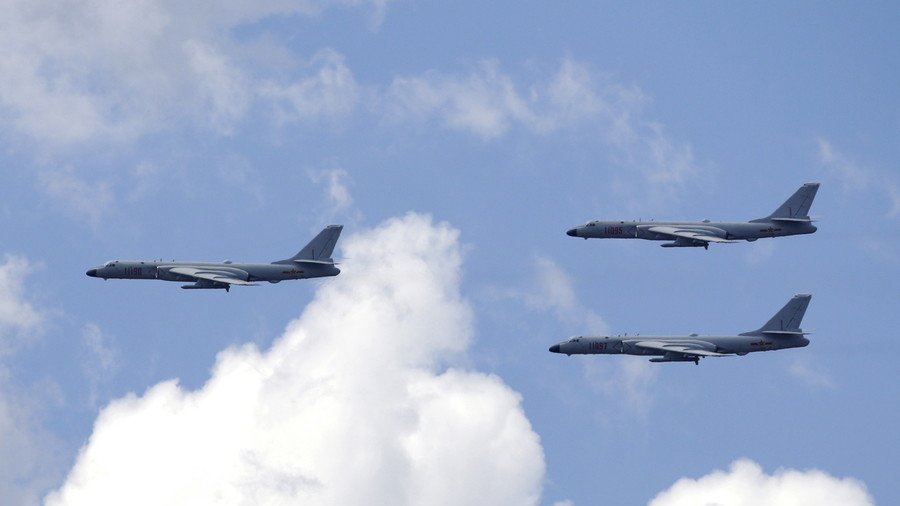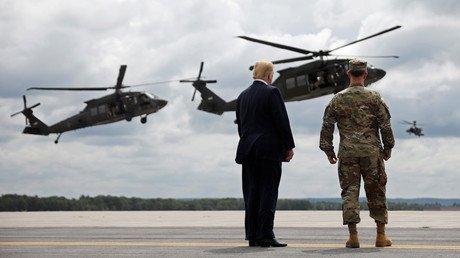Pentagon hypes China threat amid renewed strategic competition

The Pentagon is raising an alarm about “rapidly” growing Chinese military capabilities, from long-range bombers to a blue-water navy, as mainstream media warn that Chinese pilots are “likely” training for strikes against the US.
Long-range bomber training missions “targeting the US” – this is how the US mainstream media reported the findings of the Pentagon’s annual assessment of Chinese military capabilities in 2017, published Thursday.
What the 145-page report actually says is that the People’s Liberation Army (PLA) air force has “rapidly expanded its overwater bomber operating areas, gaining experience in critical maritime regions and likely training for strikes against US and allied targets.”
China is actively developing its fleet of long-range bombers and "likely" training its pilots for missions targeting the US, according to a new Pentagon report https://t.co/dgP1O2hs1Jpic.twitter.com/VLVVkIoJin
— CNN International (@cnni) August 17, 2018
From that passage, it is clear that the Pentagon is concerned about Chinese capabilities against forward US bases in places like South Korea, Japan, the Philippines and maybe even Guam – not the continental US, which China can already reach with nuclear missiles anyway.
The US military seems particularly alarmed by the prospect of China developing long-range bombers. A “stealthy, long-range strategic bomber with a nuclear delivery capability” could be operation “within the next 10 years,” the report says, completing the so-called “nuclear triad” of delivery systems.
It must be purely a coincidence that this assessment comes as the US is working on developing a next-generation long-range bomber, and has invested heavily in the F-35 fighter program, estimated to cost over $1.5 trillion over its lifetime.
The report also contains claims that China is developing weapons to target US satellites in orbit, including “kinetic-kill missiles, ground-based lasers, and orbiting space robots.” This is in no way likely to be used to drum up support for President Donald Trump’s “Space Force” plans, of course.
The annual report on Chinese capabilities is mandated by US law. It is also the first such report since the adoption of a new national defense strategy in January, which called “inter-state strategic competition, not terrorism,” the primary concern for the US.
A two-page fact sheet accompanying the report offers clues as to China’s actual military priorities: the current goal is mechanization, with partial “informatization” being a goal for 2020 and “basic modernization” by 2035. The Chinese leadership aims to have a world-class military “by the middle of this century,” the fact sheet says.
In 2017, Beijing actually cut 300,000 personnel from its ground forces and reorganized them on a brigade structure. The PLA Marine Corps is being expanded, going from 2 brigades and 10,000 personnel to a projected 30,000 marines in seven brigades by 2020, according to Pentagon projections. This expanded marine corps would also be able to engage in “expeditionary operations” - the likes of which the US Marines have conducted since going to the Shores of Tripoli in 1801.
Beijing continues to build destroyers and frigates, as well as submarines, for the People’s Liberation Army Navy (PLAN). China’s first aircraft carrier, the Liaoning, conducted its first training deployment in 2017.
The report also brings up the expansion of People’s Armed Forces Maritime Militia (PAFMM), based around a fleet of state-owned fishing vessels operated in coastal areas. Clearly, the Pentagon is facing a “fishing boat gap” that needs to be addressed forthwith.
MY TAKE: #China’s #MaritimeMilitia is known clearly to the US gov't. By documenting these important facts officially & authoritatively, the Pentagon’s 2018 China report has performed a signal service: Revealing the PAFMM & its true nature is important to deterring its future use.
— Andrew Erickson 艾立信 (@AndrewSErickson) August 16, 2018
While Beijing is undeniably expanding its military capabilities, that buildup has to be seen in context. China currently has only one overseas base, in the East African country of Djibouti, and its military budget for 2018 was estimated at $175 billion.
Meanwhile, the US has nearly 800 military bases around the globe, and President Trump just signed a bill authorizing the Pentagon to spend $716 billion in 2019 - up from $700 billion this year.
Think your friends would be interested? Share this story!















